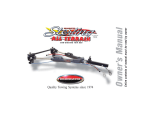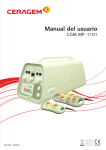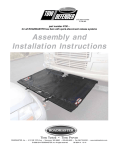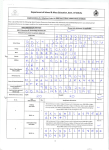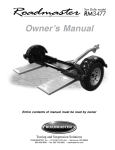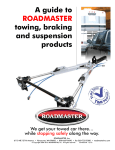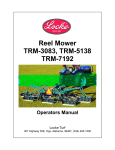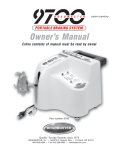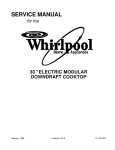Download Roadmaster RM-BH1 Specifications
Transcript
Falcon 852482-08 Installation Instructions All specifications subject to change without notice 05/14 ROADMASTER, Inc. 6110 NE 127th Ave. Vancouver, WA 98682 Owners and installers must read the installation instructions and carefully note the warnings! 800-669-9690 Fax 360-735-9300 www.roadmasterinc.com Figure 1 Tow bar rated at 6,000 pounds Quick-disconnect parts list: (2)quick-disconnects (parts “A” and “B”) (2)safety plates (“C”) All mounting hardware Installing the ‘quick-disconnect’ system T his tow bar is equipped with an exclusive “quick-disconnect” (or, “QD”) system. Before connecting the tow bar to the vehicle, first install the components of the QD system to the mounting bracket. Note: the quick-disconnect system is not used with ROADMASTER ‘MS’ or ‘MX’ series mounting brackets. If the towed vehicle has MS or MX brackets, proceed to “Connecting the tow bar.” The quick-disconnect system should be reserved, however, for subsequent vehicles which may not have these brackets. 1. First, attach the quick-disconnects (“QDs,” parts “A” and “B” in Figure 1) to the tow bar mounting brackets. Attach the QDs so that the vertical pin on each is pointing up, as shown in Figure 1. Attach part “A” on the passenger side, and part “B” on the driver’s side. Use the supplied ½" x 1¾" bolts, the two safety plates (parts “C”), and the flat washers, lock washers and nuts, as shown in Figure 1. Both QDs have an extra hole — “D” in Figure 1 — for safety cable attachment. Mount parts “A” and “B” so that the “D” holes are to the outside. Do not tighten any of the bolts — leave them loose for now — they will be tightened later. Use all mounting hardware and both safety plates. If all supplied materials are not used, the quick-disconnects, the quick-disconnect bases or other components may vibrate loose, which may cause property damage, personal injury or even death. 2. Test-fit the crossbar — lower the crossbar (Figure 2) over the quickdisconnects. The vertical pins at the top of both QDs should fit through the top holes at the ends of the crossbar (Figure 2), and the vertical pins at the bottom of the crossbar should fit through the lower holes on the quick-disconnects (Figure 2). 3. The quick-disconnects must be positioned so that the tow bar is centered on the front of the vehicle. If necessary, adjust the quick-disconnects by moving them to the left or the right, until the tow bar is centered to the front of the vehicle. The quick-disconnects must be centered on the mounting brackets. If they are attached too far to the left or the right, the tow bar will Figure 2 not be centered on the towed vehicle, which will cause excessive tire wear and other consequential, non-warranty damage. 4. Once the crossbar slides on and off easily, torque the four bolts to 75 ft./lbs. Again, test-fit the crossbar over the QDs, to verify that the crossbar slides on and off easily. If it does not, adjust the QDs again. 5. Insert the linch pins (Figure 2) through the upper holes in the vertical pins on both QDs. All linch pins must be locked. The rings are spring-loaded — they must be snapped over the pins, with the curved side of the linch pin touching the ring, in order to keep the QD bases secure. Towing vibrations will force the linch pins out unless they are properly locked in place over the vertical pins on both quick-disconnects. Failure to properly attach and lock all linch pins will result in the loss of the towed vehicle, which may cause property damage, personal injury or even death. Installer’s safety checklist • Stress to the owner that the tow bar must be within the ‘Safe Zone’ — no more than three inches above or below level. Towing with an out-of-level tow bar will cause significant wear and tear on the tow bar and mounting brackets, and on the towed vehicle’s suspension and frame. (See the section titled “Stay within the ‘Safe Zone’” for further information.) • Show the owner how to properly operate the tow bar. Familiarize yourself with the features of the tow bar. Demonstrate them to the owner, and ask the owner to connect and disconnect the tow bar and other components of the towing system, until the owner is comfortable with its operation. • Caution the owner to use a receiver hitch rated higher than the actual weight of the towed vehicle. The motorhome receiver hitch must have a minimum capacity of no less than the weight of the towed vehicle and all its contents. (The Falcon All Terrain tow bar is rated at a maximum of 6,000 pounds carrying capacity; therefore ROADMASTER has used 6,000 pounds as a standard for rating the weight capacity of all supplementary towing equipment, as well as the towed vehicle and all its contents, throughout these instructions.) • The tow bar must be attached to a bracket which is bolted to the towed vehicle’s frame or unibody. In order to be towed, virtually all vehicles require a tow bar mounting bracket that is connected to the frame, unibody or chassis and extends beyond the bumper. • Caution the owner to secure the tow bar with linch pins (or optional padlocks) before towing. Unless the tow bar is secured to both vehicles with all appropriate pins (or padlocks), the towed vehicle will detach. • Read the instructions thoroughly before installing the ‘quick- Stay within the ‘Safe Zone’ T owing with a motorhome-mounted tow bar which has an upward or downward slope puts undue strain on the entire towing system. For that reason, do not tow if the tow bar is not within the ‘Safe Zone’ — no more than three inches above or below level. Towing a vehicle with a tow bar that is not within the Safe Zone will result in significant wear and tear on the tow bar and brackets, significant wear and tear on the vehicle’s suspension and frame, and the eventual failure of the towing system. To determine if the tow bar is within the Safe Zone — first, connect the motorhome and towed vehicle on level ground. Next, measure the distance from the center of the motorhome receiver down to the ground. Then, measure the distance from the center of one of the base pins Figure 3 down to the ground. Compare these two measurements. To be within the Safe Zone, they cannot be more than three inches apart if the base pin is above or below the motorhome hitch receiver. See Figure 3. If the tow bar is not within the Safe Zone, you must purchase a hitch accessory to raise or lower the hitch receiver. ROADMASTER has three accessories available — Hi-Low Hitches, Hi-Low Drops, and Dual Hitch Receivers — which will raise or lower the hitch receiver from two to 10 inches, depending on the model. Towing with the tow bar more than three inches above or below level will void the ROADMASTER warranty. Failure to follow these instructions may cause property damage, personal injury or even death. 2 disconnect’ (‘QD’) system and its components. The tow bar will be attached to the QD system. If the QD system is not properly aligned, centered and positioned on the towed vehicle, the tow bar will not be centered on the towed vehicle, which may cause excessive tire wear and other consequential, non-warranty damage. • Advise the owner to use 6,000 pound or higher rated safety cables. • The installer must be sure that the vehicle is suitable or adaptable for towing. Some vehicles must be equipped with a transmission lube pump, an axle disconnect, driveline disconnect or free-wheeling hubs before they can be towed. Failure to properly equip the vehicle will cause severe damage to the transmission. Check the manufacturer’s instructions for the proper procedure(s) to prepare the vehicle for towing. • The installer must NOT use the tow bar as a ground for welding. Connecting a ground to the ‘A-frame’ of the tow bar will cause current to flow through the locking spring, which will detemper the spring and destroy the locking mechanism. • Under no circumstances should the tow bar be welded to the vehicle, nor should any of the pre-punched mounting holes be altered. Any welding or altering of the tow bar will void the owner’s warranty. ailure to follow these instructions may cause property damage, perF sonal injury or even death. Connecting and disconnecting Use caution when handling the tow bar — if your hands, fingers or any part of your body are caught between moving components, they can be pinched, cut or otherwise injured. Connecting the tow bar 1. First, attach the tow bar quick-disconnects — refer to “Installing the ‘quick-disconnect’ system.” Note: the quick-disconnect system is not used with ROADMASTER ‘MS’ or ‘MX’ series mounting brackets. Instead, the tow bar is connected directly to the mounting bracket with the base pins and linch pins. With this exception, the instructions below apply. 2. Drive the vehicle within three or three-and-a-half feet of the motorhome hitch receiver. The vehicle does not have to be perfectly centered to the hitch receiver, just close. Then, put the vehicle in gear (park), set the emergency brake and chock one of the wheels. 3. With the tow bar in the folded position, insert the stinger into the motorhome hitch receiver and attach the stinger to the hitch receiver with the hitch pin and clip. Attach the tow bar so that the locking mechanisms and the release latch are pointing up. Components of the tow bar may be damaged if the tow bar is attached with the release latch and the locking mechanisms pointing down. 4. Hold both tow bar arms firmly and rotate them up, so that they are vertical. Never release the tow bar arms when they are in the vertical position. The arms can fall and cause severe personal injury. 5. Push the release latch forward, to bring both arms down to a horizontal position. Standing to one side, swing both arms away from you. Then, align the holes in the outermost arm with the holes in one of the tabs on the quick-disconnect base. Attach the tow bar arm to the quick-disconnect base with one of the included base pins. Attach the arm so that the head of the shoulder bolt is facing up. Lock the base pin with a linch pin or optional padlock. The linch pin must be locked. The ring is spring-loaded — it must be continued on next page Connecting the tow bar continued from page two snapped over the pin, with the curved side of the linch pin touching the ring, in order to keep the base pin secure. Both tow bar arms must be attached to the quick-disconnect bases and locked with a linch pin. Towing vibrations will force the linch pins out unless they are properly locked in place over the base pins on both quick-disconnect bases. Failure to properly install and lock both base pins will result in the loss of the towed vehicle, which may cause property damage, personal injury or even death. 6. Now, swing the other arm to the opposite side and connect it in the same manner. 7. Attach the safety cables and plug in the electrical wiring cord, according to the supplier’s instructions. Before towing the vehicle, be sure the steering is unlocked, the transmission is in the proper setting, and the emergency brake is released. Remove the wheel chock. Check the manufacturer’s specifications or the owner’s manual for the proper towing procedure(s) or requirement(s) for the vehicle to be towed. Do not tow the vehicle until the tow bar is attached with all pins or padlocks. Unless the tow bar is secured to both vehicles with all appropriate pins or padlocks, the vehicle will detach, which may cause property damage, personal injury or even death. When you drive away, steer briefly to the left and then to the right, to extend, self-center and lock the tow bar. Always stop at this time. Check the tow bar to ensure that both arms are locked before assuming highway speed. Additionally, check the other components of your towing system, to ensure that they are fully engaged. Both tow bar arms must be locked before towing. If they are not, the momentum of the towed vehicle will apply excessive force to the tow bar arms and other components of the towing system, which may cause the towing system to fail, resulting in property damage, personal injury or even death. Do not tow a vehicle using tow bar mounting brackets, safety cables, or a hitch receiver rated less than the actual weight of the towed vehicle. If the brackets, safety cables, hitch receiver or any supplementary towing equipment is not rated at the weight of the towed vehicle and all its contents, it may fail during towing, causing property damage, personal injury or even death. If the motorhome hitch receiver has an extension, do not tow if the tow bar is more than three inches out of level. Receiver extensions cause the towing system to swing much higher and lower than towing systems without extensions. This enlarged arc of motion creates excessive strain on the tow bar, brackets and frame, which can cause the towing system to fail, causing property damage, personal injury or even death. Disconnecting the tow bar 1. Disconnecting the tow bar is essentially the reverse of connecting it. First, always try to park on level ground, with the towed vehicle in line with the motorhome. This will eliminate most of the tension between the vehicles, allowing for an easier disconnect. 2. Disconnect the electrical wiring harness, safety cables and any other towing system accessories. 3. Lift the release handles on each tow bar arm to release the locking mechanisms. (Usually, one of the handles will require more pressure to release. This is the arm that has the majority of the tension between the two vehicles.) Always put the towed vehicle in gear (park), set the emergency brake and chock one of the wheels after lifting the release handles, and before removing the base pins. Failure to do so may result in a ‘runaway’ vehicle or may crush you between the towed vehicle and the motorhome, causing property damage, personal injury or even death. 4. Put the towed vehicle in gear (park), set the emergency brake, and chock one of the wheels. 5. Remove the base pins and store the tow bar on the motorhome by reversing the connection procedure (under “Connecting the tow bar”). ROADMASTER recommends replacing at least one of the linch pins with a padlock (part number 301, 302 or 308) to prevent accidental release or theft. If you choose to store the tow bar on the back of the motorhome — The bushings at the end of the tow bar arms can be warped by heat from the exhaust. If the bushings are warped, the tow bar arms will not slide easily, or they may not slide at all — it may be difficult to connect or disconnect the tow bar, or you may be unable to connect or disconnect it, until the bushings are replaced. The tow bar can be stored on the motorhome with the arms rotated to the left or the right. To avoid the possibility of damage to the bushings, rotate the arms away from the engine exhaust. How to use safety cables Safety cables are an integral part of your towing system. They are a secondary safety device, required by law in many states. This section, and the following section, will acquaint you with how to use them properly. •The safety cables must connect the towing vehicle to the towed vehicle, frame to frame. •The safety cables must be rated at 6,000 pounds weight capacity per pair, or higher. This is the maximum weight capacity of the tow bar — the towed vehicle and all its contents cannot exceed 6,000 pounds. •Pull the safety cables so that all the slack is at the motorhome. Make sure there is enough slack in the cables at the motorhome to allow for sharp turns — if there is not enough slack, the towing system will be severely damaged when the motorhome turns a sharp corner. • The safety cables must be the correct length… • Make sure the cables are not too short — if you use a receiver hitch extension or other equipment that extends the distance between the towed vehicle and the motorhome, the standard cables may be too short. If the cables are too short, the towing system will be severely damaged when the motorhome turns a sharp corner. (Safety cable extensions in a wide variety of lengths are available from ROADMASTER.) • Make sure the cables are not too long — the cables should not hang down to the extent they may catch on obstructions, or drag on the ground. This much slack could cause damage to the towing system, the towed vehicle, or the motorhome. If the cables are too long, wrap the excess cable around the tow bar to take up the slack. Make sure there is enough slack in the cables at the motorhome to allow for sharp turns. Damage caused by using safety cables of an incorrect length is not covered under warranty. • Always cross the cables under the hitch receiver, as shown in Figure 4 under “Proper installation of safety cables.” In the unlikely event the tow bar separates from the motorhome, crossing the cables will help prevent the tow bar from dragging on the ground, which can cause the tow bar to “pole vault” the towed vehicle. • Some ROADMASTER tow bar mounting kits with removable arms use two safety cables on each side. If two sets of safety cables are required, both must be used. This is required by law. Refer to “Proper installation of safety cables” for further information. Failure to follow these instructions may cause property damage, personal injury or even death. 3 Option 2 Figure 5 Option 1 (Safety cable anchor is not present on all brackets) Figure 4 Proper installation of safety cables For all towing systems… Use the built-in cable guides and cross the safety cables under the hitch receiver, as shown in Figure 4. Unscrew the connecting nuts on each quick link to connect the safety cable loops. Finger-tighten the nuts firmly, until the loop is completely closed, to secure the attachment. Do not substitute carabiners or other devices for the quick links — the quick links are designed to hold the weight of a towed vehicle; carabiners are not. Option 1 If the tow bar mounting bracket is similar to the one shown in Figure 4 and the safety cables are long enough, connect the snap hook (or quick link) to the safety cable anchor built into the mounting bracket. Note: the snap hooks can be attached at either the towed vehicle or the motorhome. But if you attach them at the towed vehicle you can quickly store the safety cables, as well as the power cord, underneath the tow bar cover (optional, part number 055-3). When you disconnect the tow bar to store it at the back of the motorhome, disconnect the cables and cord at the towed vehicle; leave them connected at the motorhome. Then fold the cables and cord up with the tow bar. Use this method only when traveling. For extended storage, see the owner’s manual. Option 2 Some ROADMASTER tow bar mounting brackets with removable arms, such as the one in Figure 4, use both a long safety cable and a short safety cable on each side. Each long safety cable runs from the towing vehicle to a quick link attaching it to one of the quick-disconnects. This quick link is also an attachment point for one of the short safety cables; another quick link attaches the short safety cable to the mounting bracket. The safety cables must be carefully routed so that they cannot become pinched, frayed, scraped or otherwise damaged, and so they will not drag when going over dips or low spots. Do not use the cables if they show any signs of wear or damage — immediately discontinue towing and replace the cables. Failure to follow these instructions will result in cable failure, which may cause property damage, personal injury or even death. 4 If the quick links are not completely tightened, with the loop closed, the safety cables may detach. In the event of a towing system failure, the towed vehicle will detach, which may cause property damage, personal injury or even death. If your towing system requires two sets of safety cables, always use both the long and the short safety cables. Connect them as shown in Figure 5. Otherwise, in the event of a towing system failure, the towed vehicle will detach, which may cause property damage, personal injury or even death. The Falcon All Terrain owner’s manual… …contains additional illustrations to accompany these instructions, as well as important safety information, the limited warranty and other information to make your towing experience safe and pleasant. Read the owner’s manual cover to cover before towing a vehicle. Time Tested • Time Proven ROADMASTER, Inc. • 6110 NE 127th Ave. • Vancouver, WA 98682 • 800-669-9690 • Fax 360-735-9300 • www.roadmasterinc.com




